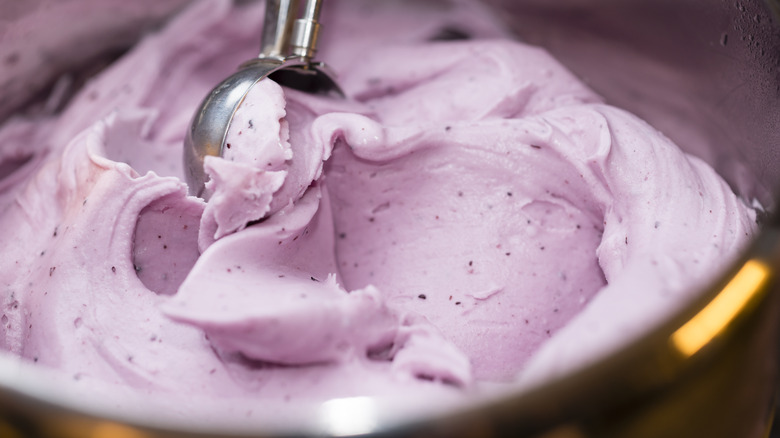The Exact Difference Between Gelato And Ice Cream
If your knowledge of ice cream mostly just covers the 31 flavors at Baskin-Robbins, it's easy to believe that ice cream and gelato are the same thing. In fact, they're different desserts that share some ingredients and flavors, and it's helpful to know the difference if you're ever interested in making ice cream or gelato.
A big difference involves the amount of fat in each. Ice cream is aptly named, because its primary ingredient is heavy cream. A standard ice cream recipe has twice as much cream as milk, while gelato has more milk than cream. Since cream has much more fat than regular milk, gelato comes out with lower fat (though gelato has slightly more sugar). The U.S. Food and Drug Administration states that ice cream needs to have at least 10% milk fat before you can call it ice cream. While the FDA has no standard for gelato, the Italian government requires gelato to be at least 3% milk fat.
Just as importantly, the churning process for gelato is different: The ingredients are churned much more slowly than regular ice cream, which makes the gelato more dense as a result.
How gelato gets churned
That lower amount of fat makes an impact on gelato's richer texture and its richer flavor — milk fat can sometimes dull the taste of a dish — but the actual way gelato is churned also plays a large role. The slower churning process of gelato means that less air gets trapped in the cream while you churn it, and this is what makes gelato more rich. Ice cream is much lighter and creamier because it's essentially filled with air bubbles, which come from churning the ice cream more heavily.
One last thing to note is that ice cream and gelato aren't just made differently, they're stored differently. Ice cream is served at a frosty zero degrees Fahrenheit (-18 degrees Celsius), but gelato is stored at a slightly warmer — but still quite cold — temperature of about 15 degrees Fahrenheit (-9.5 degrees Celsius). The reason for this is gelato's density because warming it a small amount makes it easier to scoop. It's also why gelato has such a soft, silky texture despite being more dense.
Desserts around the world
Ice cream and gelato come from different corners of the world. Perhaps you already know that gelato comes from Italy. In Italian, the word gelato literally means "frozen." While the word is also used as a generic term for ice cream within Italy, what the wider world calls gelato likely first appeared in the 1500s in Italy, and it became more popular when a Sicilian restauranteur opened a gelato parlor in Paris. Ice cream is much older: While some date its origins to ancient China, iced desserts go all the way back to Mesopotamia. Indian kulfi is a specific iced dessert from the 1500s that seems closest to modern ice cream.
Gelato is still most popular in Europe: Italy has the most, followed by Germany, Poland, and Spain. Ice cream is more popular around the world: The United States is second in ice cream consumption, behind New Zealand.
On a final note, you might also be wondering about other similar treats like sorbet. There are no dairy products at all in sorbet, and it's instead made with sugar and often fruit puree. Sherbet is fruity much like sorbet, but contains a small amount of milk fat.


